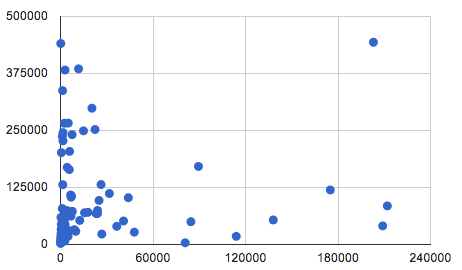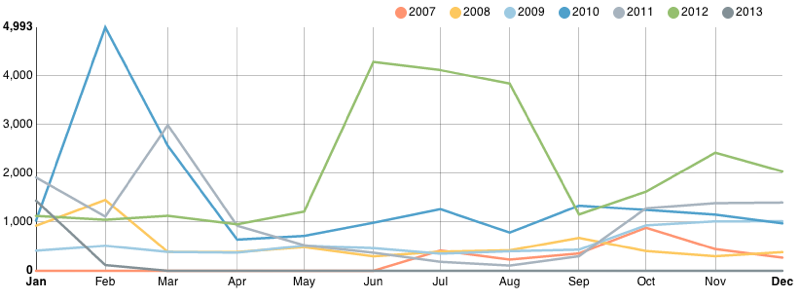Links to your site from other websites (what we call backlinks) are a good thing. It’s not just that people might click on them and come to your site. The more backlinks you have, the more chance people will find your website when using search engines.
If you’re not sure why, here’s a quick primer. Search engines see a link to a page as a vote of confidence, the rationale being ‘someone linked to it therefore it must be good’. Search engines will take the number of links to a given page into account when calculating search results – pages with more links are more likely to show up higher in search results.
With this in mind, I wondered how many backlinks the organisations in my sample group of UK arts organisations have gathered.
Findings
I used MajesticSEO’s historical index to look at the number of backlinks for each of the websites in my sample group. The spreadsheet below shows the number of backlinks for each organisation.
So what does this tell us? Well, not a huge amount – it’s a limited picture, as I’ll explain below. However, it gives us some context when looking at an individual site. You might expect the large venues that promote a large number shows and sell their own tickets to garner lots of links and that’s shown to some extent. Organisations that tour to other venues are likely to get fewer (all else being equal).
You might expect a correlation between the size of a website and the number of links (more pages = more content to link to) but, using the data from my last Arts Analytics post on indexed pages (and excluding some of the outliers) that doesn’t seem to be the case.
Ah well. Of course, attempts to draw correlations like that will be skewed by the fact that too many arts organisations treat their websites in backlink-unfriendly ways. I’ll get on to that.
Going further
The figures here are really just a starting point. If we were doing some proper analysis then there are other things we’d want to dive into:
- The quality and relevance of the sites sending those links.
- The types of anchor text used.
- Which particular pages tend to attract a higher percentage of links.
- How those links have accumulated over time.
That last one is particularly interesting if you’ve got a particular competitor you’re matching yourself against. For instance, the graph below shows how Battersea Arts Centre have gathered backlinks over the past few years. I wonder what was happening there in the summer of 2012?
A few more thoughts about backlinks
As a website owner, ideally you want links from a variety of relevant, authoritative websites pointing to a variety of pages on your site. Compared to many other sites out there, prominent arts organisations don’t tend to have much difficulty attracting links. People want to talk about them online and often their website is the place to send people to buy tickets.
From the research I’ve done in the past, you tend to find that the bulk of those links naturally gather around the homepage and event/production pages. There might then be the occasional blog post, educational resource or collection item that attracts a lot of attention (but there are much fewer of these).
Arts organisations are devils for producing blogs and microsites that sit on different domain names, away from their main site. These things often attract links (especially if a microsite is part of a marketing campaign) that could otherwise be further strengthening the prominence of their main website in search rankings.
A quick note about anchor text. The text that constitutes a clickable link is also noted by search engines. As a result, example 1 below is much preferable to example 2:
- Click this link to go to the Southbank Centre website.
- Click this link to go to the Southbank Centre website.
There are other reasons for paying attention to anchor text, but the general message is you should never (ever) let me catch you linking somewhere with something as generic as ‘click here’.
I could go on about links. I think I’ll stop there.
Recommendations
- Don’t delete pages from your website if you can help it – you’ll break all the links that were pointing there. NB: ‘But the event has passed’ is not a good reason for deleting a page, it’s a good reason for flagging a page as ‘archived’ like the Royal Court do (they’re a client).
- Don’t churn out blogs, minisites and landing pages on random domain names away from your main website unless you really have to (and even then…).
- Use permalinks rather than dynamically-generated URLs.
- Take a look at how many backlinks your competition or peers have. Who’s linking to them? Are they linking to you too? If not, why not?
- Look at which pages people tend to link to on your own site. Why are some pages more popular than others. If nobody’s linking to revenue-driving pages (ie venue hire) then maybe it’d be useful to do something about that.
- Have people been linking to you more or less over time? What are you doing to encourage (or dissuade) that sort of thing?
This post is part of a series called Arts Analytics where I’m using digital metrics to see what a group of arts organisations are doing online. For some tasty extras, sign up to the free Arts Analytics newsletter.
If you found this post useful then please share it with others who might get something out of it (there are some social sharing buttons for you below).

